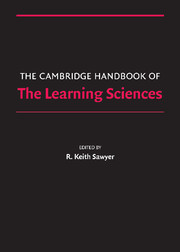Book contents
- Frontmatter
- Contents
- Preface
- Contributors
- 1 Introduction
- PART I FOUNDATIONS
- PART II METHODOLOGIES
- 8 Learner-Centered Design
- 9 The Evolution of Design Studies as Methodology
- 10 Design-Based Research
- 11 Guiding Inquiry-Based Math Learning
- 12 Analyzing Collaborative Discourse
- 13 Assessing for Deep Understanding
- PART III THE NATURE OF KNOWLEDGE
- PART IV MAKING KNOWLEDGE VISIBLE
- PART V LEARNING TOGETHER
- PART VI LEARNING ENVIRONMENTS
- Afterword: After How Comes What
- Epilogue: The Fundamental Issue in the Learning Sciences
- Author Index
- Subject Index
- References
8 - Learner-Centered Design
Reflections on the Past and Directions for the Future
Published online by Cambridge University Press: 05 June 2012
- Frontmatter
- Contents
- Preface
- Contributors
- 1 Introduction
- PART I FOUNDATIONS
- PART II METHODOLOGIES
- 8 Learner-Centered Design
- 9 The Evolution of Design Studies as Methodology
- 10 Design-Based Research
- 11 Guiding Inquiry-Based Math Learning
- 12 Analyzing Collaborative Discourse
- 13 Assessing for Deep Understanding
- PART III THE NATURE OF KNOWLEDGE
- PART IV MAKING KNOWLEDGE VISIBLE
- PART V LEARNING TOGETHER
- PART VI LEARNING ENVIRONMENTS
- Afterword: After How Comes What
- Epilogue: The Fundamental Issue in the Learning Sciences
- Author Index
- Subject Index
- References
Summary
As new information technologies have emerged, whether radio, television, or computers, advocates of those technologies hoped that each would have a radically transformative effect on education. However, in many ways, the scope of the resulting educational transformation was less than many had hoped for. In the last two decades, a wide range of new information technologies, such as personal computers, handheld computers, wireless networking, and the Internet, have emerged that again have a potential to transform education. Cuban (1986) noted some reasons why previous technologies have been less than successful for supporting learning. First, there is a failure to understand how technologies must be shaped to support the needs of learners. Second, there is a failure to understand how technologies can be effectively integrated into educational contexts in ways that truly support learning activities and goals. Therefore, if computers are to positively impact learning, educational software must be designed around learners' goals, needs, activities, and educational contexts. This approach to designing software is called learner-centered design (LCD) (Soloway, Guzdial, & Hay, 1994).
Here we will provide an overview of learner-centered design and summarize how it is different from typical software design approaches. We will discuss both the critical role of scaffolding in learner-centered design and how software can serve a scaffolding function for learners. We will describe different design frameworks that can impact LCD by guiding designers and researchers in developing intellectual support in software.
- Type
- Chapter
- Information
- The Cambridge Handbook of the Learning Sciences , pp. 119 - 134Publisher: Cambridge University PressPrint publication year: 2005
References
- 5
- Cited by



